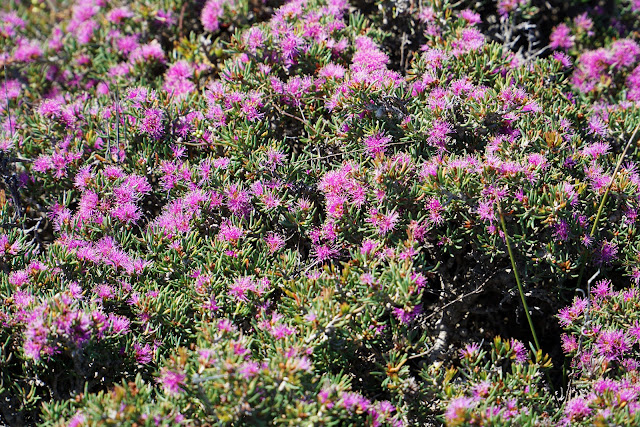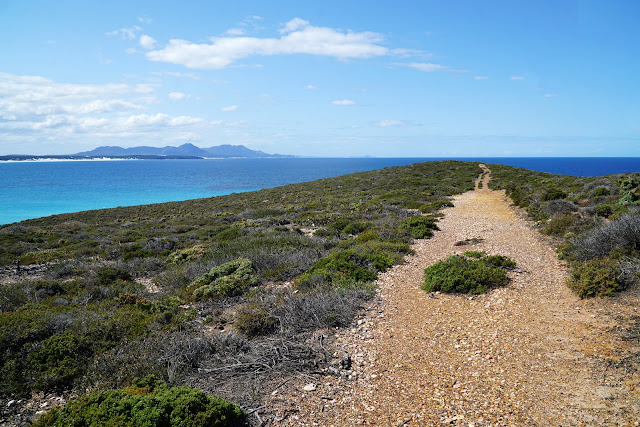A very short but enjoyable walk in Fitzgerald River National Park, the Point Ann Heritage Trail explore the landscape of Point Ann while engaging with its heritage values. Starting at the Point Ann car park, the trail passes by a section of the infamous Rabbit Proof Fence before heading back along Point Charles Bay taking in spectacular coastal views. Featuring wildflowers blooms in Springtime, this is short trail well worth checking out
Distance: 1 km (loop)
Gradient: Relatively flat over its entire length
Quality of Path: A well constructed and maintained single file walk track with some vehicle track towards the southernmost part of Point Ann
Quality of Signage: Generally well signed and clear, with multiple didactic panels over its length
Experience Required: No Bushwalking Experience Required
Time: <1 Hour
Steps: Some steps leading down to the day use area
Best Time to Visit: Spring
Best Time to Visit: Spring
Entry Fee: Yes. National Park Fees apply.
Getting There: The trail starts at the West Mount Barren car park. Access to the area is off South Coast Hwy (National Route 1). Take the unsealed roads along Devils Creek Rd, right onto Pabelup Dr and continue to the end of the road. Trailhead is located on the right side of the car park when facing the oceanAfter successfully completing West Mount Barren, it was time for me to keep heading down the road to tick off the other short walk in the park's western side - the Point Ann Heritage Trail. Being a positively tiny 1 kilometre in length, I'd given it very little attention when we visited in 2016, however as a Fitzgerald River fan I was keen to see what it offered. Starting at the same car park as the Mamang Trail, the trailhead for the Point Ann Heritage trail is to the right of the car park when facing the ocean. As is typical of Fitzgerald River walks, the trail has a brush down station at its start to help stop the spread of Dieback.
Immediately, I could see what we stand to lose if Dieback takes hold; as with every walk in Fitzgerald River National Park, the wildflower display is magnificent. Being coastal in nature, the heathland here was different to what I had encountered at West Mount Barren, which meant a myriad of different plant species.
The reason for the existence of the Point Ann Heritage Trail becomes quite clear within the first 100 metres as a series of signs appear. Regular hikers in Western Australia will recognise the symbols of the 1988 Bicentennial - a time where any trail that had the word 'Heritage' in its title was almost certain of getting funding. Some of these trails are somewhat dubious in terms of significance, but Point Ann is legitimately historic as it was the southern end of the infamous Rabbit Proof Fence.
The initial stretch of the trail heads through continuous low coastal heath, with the trail appearing to have been recently upgraded with perfectly well formed walk track.
While initially difficult to see, continuing along the track reveals views of the Central Wilderness Peaks and the spectacular expanse of Point Charles Bay. This is one of my favourite parts of Western Australia, and I would argue that the view of the Central Wilderness is more impressive from Point Ann and that start of the Mamang Trail than it is even from the end of the Hakea Trail at Quoin Head lookout.
While many of the older Bicentennial signs are still in place, Parks and Wildlife have put some effort into new informative signage that matches the style of the newer signs seen in the park. Unlike the Hakea and Mamang Trails - where laziness or lack of will has resulted in signs being left blank for years now - all the signs for the Point Ann Heritage Trail are in place, and help interpret the history of the Rabbit Proof Fence.
With the trail widening to a vehicle track, a series of wooden posts stand as some of the last few remaining posts in this southernmost section of what was the longest fence in the world.
Beyond the posts, it is interesting to see the slowly corroding remains of the chain link fence itself lying next to the track and going back into nature. Seeing so much of it here even though so few of the posts remain, I had to wonder how much of the chain link has survived intact in other parts of the fence and how easy it is to follow by those crazy/driven enough to want to walk along a fence for kilometres on end.
Following what is essentially the old service track for the fence, the trail heads towards the southern tip of Point Ann, with the spectacular Point Charles Bay and the Central Wilderness Peaks dominating the view.
Looking west of Point Ann, I was amazed by how blue the waters were on this less sheltered side of the point. From here, some ad hoc goat trails run closer to the edge and provide a vantage point to take in the ruggedness of the Fitzgerald coastline.
Looking down and back along the coast, the typically jagged sedimentary rock that is common to the Fitzgerald River area make for stunning coastal scenery. I was amazed at how calm the waters were here; in most areas along the south coast of Western Australia, falling in looks like almost certain, instant death, while the waters here looked like you'd have a fighting chance of survival if you didn't land on any rocks.
Back on the main trail, another of the Bicentennial signs appears at the tip of Point Ann, with the sign providing information about the names of the mountains ahead and their naming by Matthew Flinders.
The return journey follows the eastern side of Point Ann along Point Charles Bay, and is just as lovely. These is classic Western Australian beach views, with St Mary Beach being one of the examples of why Western Australia arguably has the best beaches in the country.
The main feature along this stretch of track is one of the two lookout points in the area that provides a perfect vantage point to view the whale migration in season. It also provides great views of the Central Wilderness Peaks and the nearby bays.
One of the nearby bays was a secluded little beach with the waters nearby filled with Fitzgerald River's jagged formations forming a reef. Given the calm conditions and the large size of the rocky reef, I was kicking myself for not bringing my snorkelling gear, and it is something I would love to come back and explore.
Approaching St Mary Beach, the day use facilities come into view. While the western side of the park is considerably more low key than the more accessible and more developed eastern side, the facilities on offer are still excellent given the money that was spent to make Fitzgerald River one of the state's premier parks.
A trail junction allows for two alternative routes to return to the car park; to the left, the trail returns back to the brush down station and trailhead encountered earlier, while the right side heads towards the day use area down a flight of stairs. Wanting to check out some difference scenery, I decided it was better to check out the day use area.
From the day use area, St Mary Beach is very easily accessed. Seeing the ocean just there and with the weather being marginally warm made me all the more disappointed that I hadn't packed snorkelling gear for the trip.
The facilities in the day use area include multiple barbecues and shelters as well as the excellent lookout/beachside lounge pictured above.
Heading past the second shelter, the trail joins back to the car park, completing the Point Ann Heritage Trail's loop.
At a tiny 1 kilometre in length, the Point Ann Heritage Trail is one of the shortest trails ever written up on the Long Way's Better, however in a lot of ways it exemplifies trail building done right; it is an engaging loop walk that has historic and natural engagement, is not heavily compromised and is filled with stunning scenery. Other than length, this is an almost perfect walk, and one that is definitely worth checking out if in Fitzgerald River National Park.




































0 comments:
Post a Comment